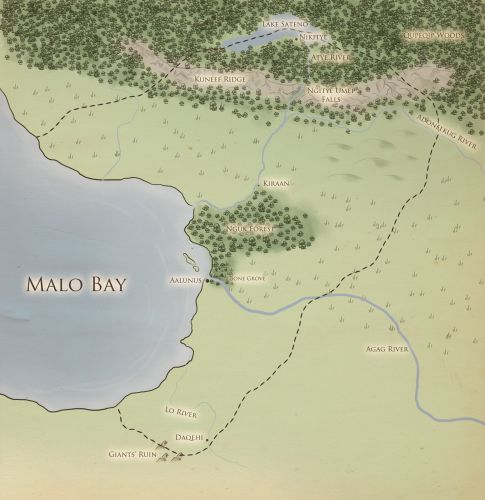Maloa
North of the Eni Belul, the desert gradually turns into a lush savanna. Along this coast is the kingdom of Maloa, a young but prospering kingdom with its wealth tied to its gold deposits.
Government
Maloa is ruled by a king. The king is elected by the noble council from the royal family, as determined by matrilineal descent. The king's mother or sister is crowned the queen. Depending on the king, the queen sometimes wields even more power than him. She is in charge of the distribution of food throughout the kingdom and manages disputes between clans. She is also queen of the woman of Maloa, and holds authority of matters pertaining mostly to women.
The heir apparent is the Grand Marshal, who is the leader of the military. This is always a member of the royal family and is almost always nominated by the king to be his successor, though this needs to be confirmed by the council. This is often a king's brother, uncle, cousin, or more distant relation if they are notably militarily inclined.
The next 3 titles are of equal rank:
Chancellor: The chief advisor to the king and head of the council
Financier: Minister of finance and managing the royal palace
General: Chief of the army below the Grand Marshal and responsible for the police. Below them are the numerous Masters of the Land, the provincial leaders and village chiefs. Fifty of them are part of the council that elects the next king.
The heir apparent is the Grand Marshal, who is the leader of the military. This is always a member of the royal family and is almost always nominated by the king to be his successor, though this needs to be confirmed by the council. This is often a king's brother, uncle, cousin, or more distant relation if they are notably militarily inclined.
The next 3 titles are of equal rank:
Chancellor: The chief advisor to the king and head of the council
Financier: Minister of finance and managing the royal palace
General: Chief of the army below the Grand Marshal and responsible for the police. Below them are the numerous Masters of the Land, the provincial leaders and village chiefs. Fifty of them are part of the council that elects the next king.
Industry & Trade
Their biggest industry is weaving and textiles. Malo textiles are some of the most prized in Kaabara, in both quality and intricacy of design. They have also mastered the production of certain dyes that make Malo fabrics distinctive.
They frequently trade their tropical crops with the Kingdom of Tanish, such as coffee and bananas, in exchange for Tanishian metals, jewels, and temperate crops like apples.
History
The kingdom was founded in 213 AR. The region had long been home to the Malo people, who lived in scattered villages. The villages were all ruled by individual Masters of the Land. One of these, a Master of one of the largest and most prosperous towns, suggested the others cooperate rather than wasting energy fighting over land. They agreed, and the original fifty members voted for a king from among them.
Architecture
Most structures are made of a combination of mud-bricks and wood. Peasant houses are often wattle-and-daub with thatch roofs, while larger buildings are made from bricks. Smooth walls are preferred, so the bricks are usually covered in plaster and smoothed out before being decorated with stripes of colour and geometric blocks. Builds are most often rounded, though straight walls lined with round arches are also popular in great houses. This style is especially popular in the drier south.
Geography
The southern part of Maloa is hot and dry. Its southern edge is only about a hundred miles from the start of the sand dunes of the Eni Belul. The majority of it is in subtropical woodlands, with green grasslands interspersed with small thickets of trees. The northern part edges into the rainforest. It sits on the west coast of Kaabara, around most of the edge of Malo Bay.
Type
National Territory
Population
486147
Location under
Included Locations



